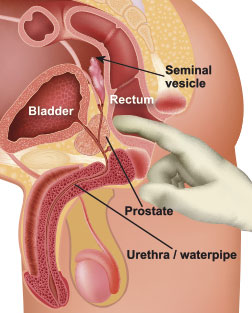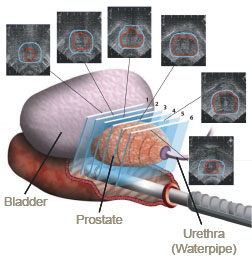
4D Brachytherapy for improved clinical outcomes

At your assessment visit
When you first come to our Centre you will probably have already had a prostate biopsy to
confirm that you have prostate cancer and you will probably have been referred to us for an
assessment to see if brachytherapy treatment is right for you.
At your first visit (your outpatient appointment) to the Centre:
- We will ask you questions about any previous illnesses, operations or medications so that we have your full medical history.
- We will ask you to complete a short questionnaire about your symptoms.
Click here to see the questionnaire you will be given. - You will need to have a comfortably full bladder when you arrive at the Centre as we will measure your urine flow rate when you are urinating.
- We will then scan your bladder to see if there is any urine left in it.
- You will have a digital rectal examination to assess the stage of your cancer
Click here to find out about the stages of prostate cancer
Click here to find out about the grades of prostate cancer
Biopsy
A biopsy is a surgical procedure in which small samples of tissue (usually 6) are removed from different parts of the prostate gland through a needle and examined under the microscope by a pathologist, a medical person specialising in identifying disease through the study of cells, tissue and organs. The procedure takes about 15 minutes and is usually performed under local anaesthetic.
The Stage of Your Cancer
The stage of your cancer refers to how far your cancer has spread. The classification commonly used to stage prostate cancer in the UK is shown here in a simplified form. (The prefix T is used to identify the tumour stage, i.e.T1 or T2). It is very important to remember that although all prostate cancers have the potential to progress, it may take many years to pass from Stage 1 to 4.
- Stage 1
Earliest stage, where the cancer is so small that it cannot be felt on rectal examination, but is discovered in a prostate biopsy or in prostate tissue that has been surgically removed to "unblock" the flow of urine (as in a transurethral resection of the prostate ? TURP). - Stage 2
The tumour can now be felt on rectal examination, but is still confined to the prostate gland and has not spread. - Stage 3
The tumour has spread outside the gland and may have invaded the seminal vesicles. - Stage 4
The tumour has spread to involve surrounding tissues such as the rectum, bladder or muscles of the pelvis.
 Rectum with ultrasound probe inserted
Rectum with ultrasound probe inserted